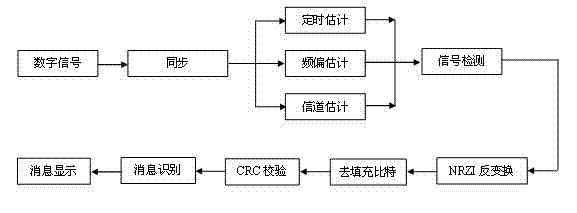Conflicting signal processing method applicable to satellite-borne AIS (automatic identification system)
A signal and single-channel signal technology, applied in the field of aerospace and marine communications, can solve the problems of AIS signal collision, large detection signal area, errors, etc., and achieve the effect of flexible configuration and expansion of detection area
- Summary
- Abstract
- Description
- Claims
- Application Information
AI Technical Summary
Problems solved by technology
Method used
Image
Examples
Embodiment
[0031] like figure 1 As shown, the known information in the frame structure includes: a training sequence serving as a frame synchronization header, a frame start flag, a data segment, a check sequence, a frame end flag, and a final buffer sequence.
[0032] AIS uses a bit-oriented protocol based on the High-Level Data Link Control (HDLC) specified in ISO / IEC 3309:1993.
[0033] The training sequence consists of alternating 0s and 1s (010101...) for a total of 24 bits.
[0034] The length of the frame start marker and the frame end marker are both 8 bits, which are composed of standard HDLC markers, and their functions are to identify the beginning and end of a frame.
[0035] The length of the data segment in a standard data packet shall be 168 bits.
[0036] The Frame Check Sequence (FCS) uses a Cyclic Redundancy Check (CRC) 16-bit polynomial to calculate the check. Only the data portion that includes bit stuffing should be included in the CRC calculation.
[0037] The b...
PUM
 Login to View More
Login to View More Abstract
Description
Claims
Application Information
 Login to View More
Login to View More - R&D
- Intellectual Property
- Life Sciences
- Materials
- Tech Scout
- Unparalleled Data Quality
- Higher Quality Content
- 60% Fewer Hallucinations
Browse by: Latest US Patents, China's latest patents, Technical Efficacy Thesaurus, Application Domain, Technology Topic, Popular Technical Reports.
© 2025 PatSnap. All rights reserved.Legal|Privacy policy|Modern Slavery Act Transparency Statement|Sitemap|About US| Contact US: help@patsnap.com



